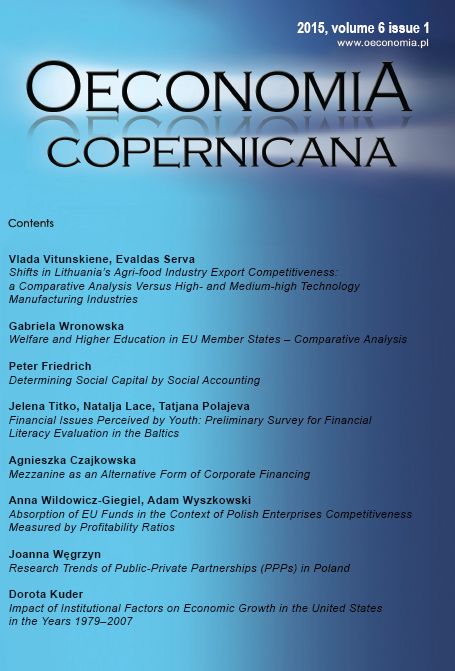Absorption of EU funds in the context of Polish enterprises competitiveness measured by profitability ratios
DOI:
https://doi.org/10.12775/OeC.2015.006Keywords:
financial results, profitability, competitiveness, EU fundsAbstract
Competitiveness at the firm level is a subject of interest not only to managers and policy makers but also academics. An effective functioning under the conditions of new economy requires from the enterprises to develop their core capabilities and talents along with the ability to quickly identify and seize the opportunities generated by market environment. The implementation of such an approach allows the creation and sustain of economic surpluses in the long-run. The paper aims to examine the profitability of enterprises in Poland which is regarded in the context of absorption of EU funds in years 2007?2013. Taking into account that Poland became one of the largest beneficiaries, it is worth analyzing the impact of EU funding on the economic performance of Polish enterprises. The paper offers a critical reflection on the relationship between the absorption of EU funds and Polish enterprises competitiveness on the basis of the content analysis literature and statistical data derived from the European Commission, the Central Statistical Office and the Ministry of Regional Development. It is assumed simultaneously that the competitiveness of enterprises is expressed in the term of profitability rates. In spite of limitations which relate to the adopted definition of competitiveness and the short period of the conducted analysis concerning the key relationship, the paper contributes to the debate on the significance of EU Funds in the process of building modern and innovative economy.
Downloads
References
Ambastha, A., & Momaya, K. (2004). Competitiveness of Firms: Review of Theory, Frameworks, and Models. Singapore Management Review, 26(1).
Laureti, T., & Viviani, A. (2011). Competitiveness and productivity: a case study of Italian firms. Applied Economics, 43. DOI: 10.1080/00036840903357439.
Feurer, R., & Chaharbaghi, K. (1994). Defining Competitiveness; A Holistic Approach. Management Decisions, 32(2). http://dx.doi.org/10.1108/00 251749410054819.
Zhang, P. & London, K. (2013). Towards an internationalized sustainable industrial competitiveness model. Competitiveness Review: An International Business Journal, 23(2). http://dx.doi.org/10.1108/10595421311305325.
Aiginger, K., Bärenthaler-Sieber, S., & Vogel, J. (2011). Competitive under New Perspectives. Brussels: European Commission. WWWforEurope. Working Paper 44.
Rolstad?s, A. (1998). Enterprise performance measurement. International Journal of Operations & Production Management, 18(9/10). http://dx.doi.org/10.1108/ 01443579810225577.
European funds for entrepreneurs. Guidebook through operational programmes 2007-2013. (2008), Warsaw: Ministry of Regional Development.
The state of implementation of NSRF 2007-2013 ? the selected aspects, according to the state as on 30 November 2014. (2014), Warsaw: Ministry of Infrastructure and Development.
The use of EU funds under the National Cohesion Strategy 2007-2013. Monthly Information for November 2014. (2014), Warsaw: Ministry of Infrastructure and Development.
Cohesion Policy: Strategic report 2013 on programme implementation 2007-2013. (2013), Brussels: European Commission.
Barney, J. B. (1996). Gaining and Sustaining Competitive Advantage. New York: Addison-Wesley Publishing Company.
Wernerfelt, B. (1984). A resource-based view of the firm. Strategic Management Journal, 5.
Hamel, G. & Prahald, C. (1994). Competing for the Future. Boston: Harvard Business School Press.
Kay, J. (1996). The Fundamentals of firm success. Warsaw: PWE Press.
Senge, P. (1990) The Fifth Discipline: The Art. And Practice of the Learning Organization. New York: Doubleday Currency.
Grant, R. M. (1991). The Resource - Based Theory of Competitive Advantage: Implications for Strategy. California Management Review, 33(3).
Teece, D. & Pisano, G. & Shuen, A. (1997). Dynamic Capabilities and Strategic Management. Strategic Management Journal, 18(7).
Igielski, M. (2014). The role of EU funds in Polish firms development. Contemporary Economy. Electronic Scientific Journal, 5(1).
Innovation Union Scoreboard 2014 (2014). Brussels: European Commission.






